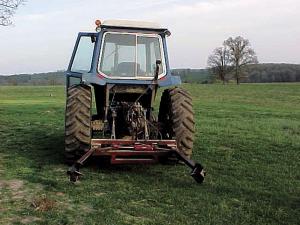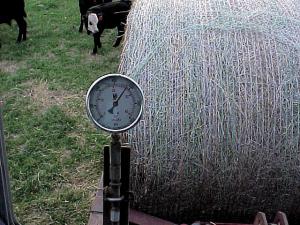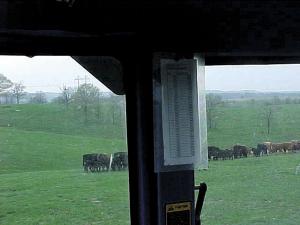2001 - Volume #25, Issue #3, Page #33
[ Sample Stories From This Issue | List of All Stories In This Issue | Print this story
| Read this issue]
Simple Hydraulic "Scale" Accurately Weighs Baled Hay
 |
 |
 |
"That makes a big difference when you're trying to feed an exact amount of hay to cattle," says the Harrison, Arkansas cattleman.
Pattie would often borrow an electronic scale from his county extension office to weigh bales. That was a bit of a hassle and he couldn't weigh every bale. What he really needed was a scale he could use as he fed the bales.
After a little thought, Pattie devised just what he needed at a cost of less than $200.
The scale works together with his 3-pt. mounted bale unroller. He started by replacing the manually adjusted top link with a hydraulic top link. Instead of plugging the cylinder into a hydraulic outlet, though, Pattie filled it with hydraulic fluid and then plugged it by running the hose into a 600 psi pressure gauge.
As a bale exerts pressure on the top link, the pressure reading on the gauge will change.
To calibrate his scale, Pattie weighed several bales on a reliable electronic scale and then picked them up with his bale unroller. Then he'd take a pressure gauge reading, unroll hay, take another pressure gauge reading and then put the bale on the scale again.
"We kept doing this until we finally had a chart to convert pounds of pressure to pounds of hay," he says.
"The biggest investment in developing the scale was the time it took to make up a calibration table," Pattie adds. The table hangs from the cab window.
Pattie made the hydraulic hose on the scale long enough to mount the gauge where he can easily read it from the cab.
He notes that you might not need the hydraulic toplink to make a hydraulic pressure gauge scale. "On some tractors, particularly older ones, the hydraulic lines to the 3-point hitch are accessible. If you could put a T into that line, you could get your pressure reading directly from the amount of pressure it takes to lift the bale," he says.
Being able to weigh bales has given Pattie better control of his feed use and costs. He says his hay is worth from 3 to 5 cents per pound, which means that every 10 lbs. of hay per day in excess of what the cattle actually need costs him $36 to $60. He figures the scale saves plenty of money.
"You need to be able to feed as much as the cattle need without underfeeding or overfeeding by too much," he says. "This takes a lot of the guesswork out of feeding hay."
Contact: FARM SHOW Followup, Joe Pattie, 722 E. South Avenue, Harrison, Arkansas 72601 (ph 870 436-5869; E-mail: jpattie@leadhill.net).

Click here to download page story appeared in.

Click here to read entire issue
To read the rest of this story, download this issue below or click here to register with your account number.




